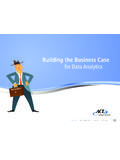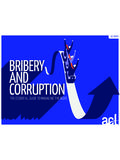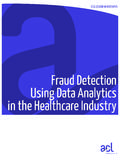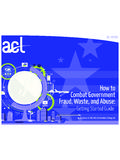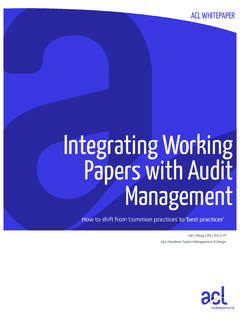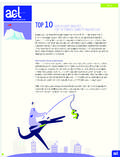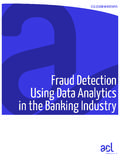Transcription of Automating Fraud Detection: The Essential Guide - …
1 ACL WHITEPAPER. Automating Fraud detection : The Essential Guide John Verver, CA, CISA, CMC, Vice President, Product Strategy & Alliances WHITE PAPER. Contents EXECUTIVE SUMMARY..3. INTRODUCTION.. 3. INTEGRATING Fraud detection THROUGH AUDIT, RISK MANAGEMENT, AND COMPLIANCE.. 3. THE ROLE OF DATA ANALYSIS IN Fraud detection .. 3. WHAT TO LOOK FOR: CAPABILITIES OF DATA ANALYSIS. SOFTWARE FOR Fraud detection .. 4. AUTOMATION OF Fraud detection ANALYTICS AND CONTINUOUS MONITORING.. 5. EXAMPLE Fraud TESTS FOR KEY BUSINESS PROCESS AREAS.. 5. Purchase to Pay (P2P).. 6. Purchasing cards (P-Cards).. 6. Order to Cash (O2C).. 6. Payroll / HR.. 6. FINAL THOUGHTS.. 7. Practical steps for implementation of data analysis technology for Fraud detection .. 7. ABOUT ACL .. 8. 2. WHITE PAPER. Automating Fraud detection : The Essential Guide Executive Summary Data analysis can play a critical role in identifying indicators of Fraud in most business process areas. By implementing risk and control data analytics to regularly monitor business transactions and integrating them into an overall risk and control process management can identify and respond quickly to red flags, and reduce the risk of Fraud escalation.
2 Through a discussion of typical frauds, detection processes and tests, you will learn how to achieve results by applying data analysis software in key business areas. Introduction During the past five or so years, surveys of senior professionals in the areas audit, risk management, compliance, and Fraud detection have consistently shown that increased use of technology is considered to be a critical factor for successful performance. More specifically, the surveys have found that data analysis software is the technology that is expected to have the greatest impact on effectiveness and productivity. So, how, in practice, can data analysis software be used to improve and automate Fraud detection processes and support overall risk management? This paper identifies some of the key issues in implementing a Fraud detection program and provides examples of Fraud detection tests for common business process areas. Integrating Fraud detection through Audit, Risk The Role of Data Analysis in Fraud detection Management, and Compliance The fundamentals of using data analysis to detect Fraud are One of the first issues to consider in implementing a Fraud detection reasonably simple.
3 Program is more of a strategic one: Ownership. Is the organizational The objective is to analyze entire populations of transactional data (as objective to integrate Fraud detection analytical testing processes well as, perhaps, master data and application control settings) in order into those of overall risk management and control, or is it instead to to look for indicators of fraudulent activities. Reliance on examination perform them within a standalone function? The specific technical of only a sample of data is insufficient for finding warning patterns, use of data analysis will not vary much in either case, but the people and also often inadequate to fulfill regulatory needs. and process aspects will usually require different considerations. Types of data analyses may vary. For example, techniques can range Data analysis, often in the form of continuous monitoring of from statistical analysis designed to look for transactions outside the transactions and controls, is increasingly used as a key component norm of what is expected, through to analytic tests that look for of risk management and audit processes overall.
4 For many specific circumstances that indicate a high probability of Fraud . organizations it makes sense to integrate Fraud detection objectives Statistical analysis produces summary reports and allows drilldown into risk management and audit processes, since the risk of Fraud is into exceptions. The second type of testing is specific, for example, a simply one among many risks that an organization faces and should test designed to identify matches between employees and suppliers. be considered within the full spectrum of risks. In other Fraudsters often take advantage of the gaps between business organizations, there may be a more specific functional area focus on systems, which typically don't exchange information. One of the Fraud , which necessitates different considerations be given to the most effective analysis techniques can be to compare data across practical aspects of implementing data analysis approaches. different databases and systems often in ways that are never 1.
5 PricewaterhouseCoopers, State of the Internal Audit Profession Study (2008-2013). 3. WHITE PAPER. normally compared. A simple example would be to examine all supplier payment transactions for instances in which a supplier name, address, or bank account is the same as an employee. One way to uncover this is to test specific database fields from, for example, an SAP ERP system in comparison with human resources records in a PeopleSoft system, using fuzzy matching logic to identify close variations on the spelling of names and address combinations. Some types of analytic procedures can appear superficially simple, such as looking for duplicate payments of an invoice made fraudulently by an employee in collusion with a vendor. In practice, however, these seemingly simple procedures may require sophisticated design in order to avoid the issue of false positives, particularly if the tests are to be performed on an ongoing automated basis. One of the biggest potential drawbacks to the use of data analytics arises when a test creates excessive numbers of exceptions for investigation.
6 An important consideration in building a Fraud detection program is to avoid this obstacle by ensuring that analytic tests take account of anomalies that are known not to be fraudulent with evolving intelligence over time. In working practice, the fewer exceptions that arise and the higher the probability that they actually indicate Fraud , the more likely that the results of testing will be actively investigated. What to Look For: Capabilities of Data Analysis Software for Fraud detection Most data analysis software designed specifically for audit, Fraud detection , and control testing have similar functional capabilities. They usually include pre-built analytic routines, such as classification, stratification, duplicate testing, aging, join, match, compare, as well as various forms of statistical analysis. The more powerful ones include a high degree of flexibility to support full automation and the development of complex tests that address the sophistication of some Fraud detection requirements.
7 One important capability to look for in data analysis software for audit and Fraud detection is that of logging of all procedures performed. This can prove to be of importance in generating complete audit trails that may be required to support detailed investigation and subsequent prosecution. Whether for Fraud detection purposes or other audit and control testing purposes, there are important advantages to analyzing data independently of an organization's application systems themselves. Data analysis technology addresses the control gaps that often exist within enterprise resource planning (ERP). systems. While ERP systems may have certain capabilities to prevent or detect Fraud and errors, or to flag exceptions, most Fraud professionals find that they not are sufficient to effectively trap the typical problem transactions that occur. For example, in many cases, certain control settings are turned off to enable the ERP system to run more efficiently. Additionally, while Business Intelligence (BI) tools are good for providing summary level information or high-level trends, they are not as effective in performing detailed testing.
8 Performing independent data analysis allows you to critically examine individual transactional details, which better enables identification of Fraud and abuse. In practice, another of the most important capabilities of data analysis technologies for Fraud detection is the ability to access a broad range of data. As mentioned, there may be a requirement to compare data from a range of data sources, both internal and external. The technical structure of data from different sources may vary considerably. Specialized Fraud and control testing software should include the ability to access and combine data in ways that are not commonly available in more general purpose analysis software or from standard ERP system reports. Program management and remediation workflow can also play a helpful role in managing a Fraud program, so stakeholders can stay on top of program activities and issues remediation. Additionally, in organizations where Fraud detection is integrated into an overall risk management process, capabilities to manage an overall risk assessment process and deliver dashboard reporting become critical in order to provide ongoing insight into strategic risks including Fraud for executives.
9 4. WHITE PAPER. Automation of Fraud detection Analytics and Continuous Monitoring Once a particular test has been developed in order to detect a specific Fraud indicator, it will often make sense to repeat the analysis on a regular basis against the most recent transactions. There are obvious advantages in detecting Fraud sooner rather than later, before the extent of Fraud has escalated. According to the Association of Certified Fraud Examiners' most recent Report to the Nations on Occupational Fraud and Abuse, the typical Fraud case continues for 18 months before it is detected. Timely risk mitigation often makes a strong business case for analyzing and testing transactions on an ongoing basis. The frequency of this form of continuous monitoring will vary depending on the nature of the underlying process. For example, in the case of monitoring payment and revenue transactions, it may make sense to perform automated testing on a daily basis. For areas such as procurement cards or purchase cards (P-Cards), travel and entertainment (T&E) expenses, and payroll, testing is more typically performed on a monthly or weekly basis in correlation with payment frequencies.
10 From a technical perspective, the progression from using a suite of Fraud specific data analytics on an ad hoc basis to that of continuous monitoring is not particularly complex. Assuming the issues of data access, preparation, and validation have been addressed and that the tests have been proven to be effective the move to continuous monitoring simply involves the regular automation of test processing. The important issues to address are those of people and process. For example: Who is responsible for reviewing and following up on the results of testing? How often is the review and follow up to take place? How are unresolved items addressed? Who is responsible for the decision to initiate in-depth investigation and interviews? Etc. Software designed for continuous monitoring supports this process by providing a workflow for remediation. This means that exceptions generated by specific tests are automatically routed to specific individuals for review. Notification of high risk exception items may be also routed to more senior management.
